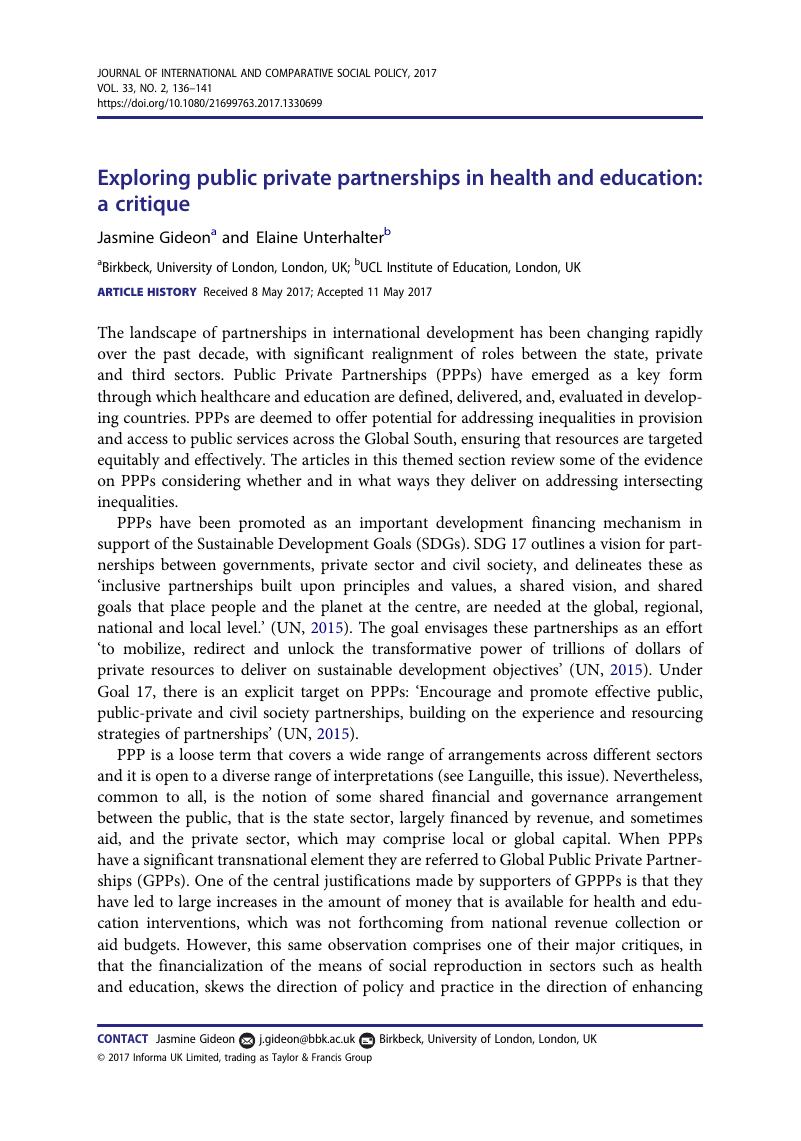Crossref Citations
This article has been cited by the following publications. This list is generated based on data provided by Crossref.
Hua, Guan-Guan
2017.
Study on the Relationship between Service Quality and Governmental Subsidy for Public School where PPP is Applied.
EURASIA Journal of Mathematics, Science and Technology Education,
Vol. 13,
Issue. 8,
Sandler, Joanne
and
Goetz, Anne Marie
2020.
Can the United Nations deliver a feminist future?.
Gender & Development,
Vol. 28,
Issue. 2,
p.
239.
Burke, Lisa M.
2020.
Tertiary Online Teaching and Learning.
p.
237.
Mitra, Romita
2020.
COVID-19 is killing education budgets: are educational public-private partnerships an answer?.
Journal of Professional Capital and Community,
Vol. 5,
Issue. 3/4,
p.
255.
Williams, Owain David
2020.
COVID-19 and Private Health: Market and Governance Failure.
Development,
Vol. 63,
Issue. 2-4,
p.
181.
Uhlenbrock, Christina
and
Meier, Henk Erik
2021.
Public-private partnerships in physical education: the catalyst for UNESCO’s Quality Physical Education (QPE) Guidelines.
Sport, Education and Society,
Vol. 26,
Issue. 5,
p.
527.
Agbemor, Benjamin Dawurah
and
Smiley, Sarah L.
2021.
Risk factors and mitigation measures in public-private water sector partnerships: lessons from the Asutifi North District, Ghana.
H2Open Journal,
Vol. 4,
Issue. 1,
p.
77.
Babacan, Hurriyet
2021.
Handbook of Global Health.
p.
2755.
Babacan, Hurriyet
2021.
Handbook of Global Health.
p.
1.
Topp, Stephanie M
Schaaf, Marta
Sriram, Veena
Scott, Kerry
Dalglish, Sarah L
Nelson, Erica Marie
SR, Rajasulochana
Mishra, Arima
Asthana, Sumegha
Parashar, Rakesh
Marten, Robert
Costa, João Gutemberg Quintas
Sacks, Emma
BR, Rajeev
Reyes, Katherine Ann V
and
Singh, Shweta
2021.
Power analysis in health policy and systems research: a guide to research conceptualisation.
BMJ Global Health,
Vol. 6,
Issue. 11,
p.
e007268.
Hunter, Benjamin M.
Bisht, Ramila
and
Murray, Susan F.
2022.
Neoliberalisation enacted through development aid: the case of health vouchers in India.
Critical Public Health,
Vol. 32,
Issue. 2,
p.
193.
Qian, Haiyan
Walker, Allan
and
Xu, Xiaohong
2023.
Running schools on two legs: The impact of policy oscillation on a public-private partnership school in China.
International Journal of Educational Development,
Vol. 100,
Issue. ,
p.
102806.
Hunter, Benjamin M.
2023.
Investor States.
Gideon, Jasmine
2023.
The Political Economy of Global Manufacturing, Business and Finance.
p.
243.
Landers, Constantin
Ormond, Kelly E.
Blasimme, Alessandro
Brall, Caroline
and
Vayena, Effy
2024.
Talking Ethics Early in Health Data Public Private Partnerships.
Journal of Business Ethics,
Vol. 190,
Issue. 3,
p.
649.
Koliev, Faradj
and
Bäckstrand, Karin
2024.
The Public Legitimacy of Multistakeholder Partnerships in Global Environmental Governance: Evidence from Survey Experiments in Brazil, the United Kingdom, and the United States.
Global Environmental Politics,
Vol. 24,
Issue. 2,
p.
146.
Gianella, Camila
Gideon, Jasmine
Salas, Mariana
Bayliss, Kate
De Falco, Rossella
Romero, María José
and
Iguiñiz, Ruth
2024.
A ‘Common Sense’ Response to Health Inequalities in Peru? Public-Private Partnerships in Health and the Implications for the Right to Health and Economic Inequality.
Journal of Human Rights Practice,
Vol. 16,
Issue. 3,
p.
836.



